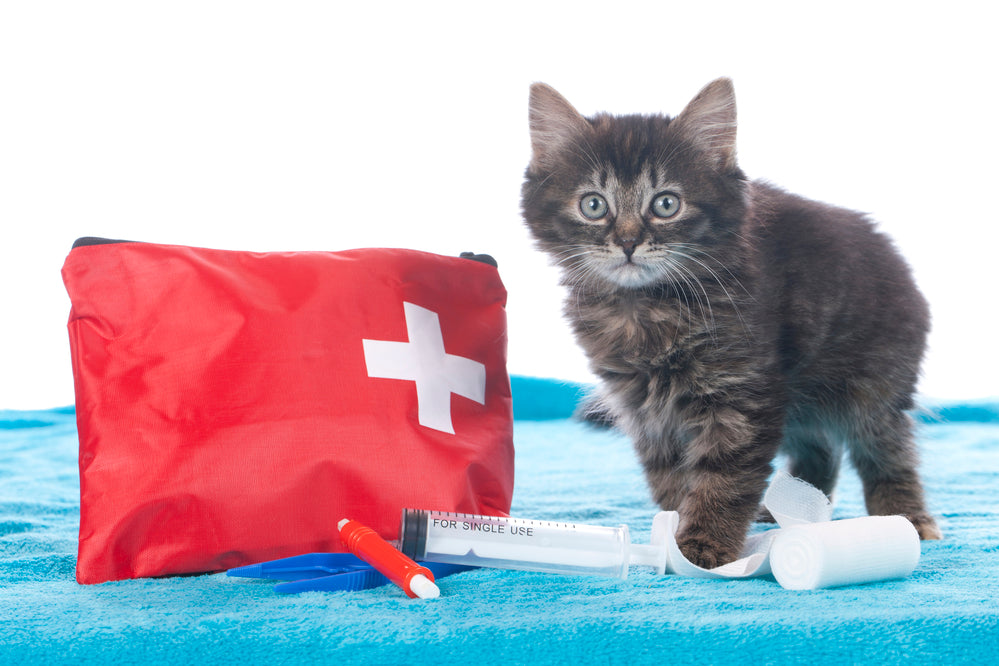Every April is Pet First Aid Awareness Month, and whether you live with cats, dogs, ferrets or other furry, finned or scaly pets, knowing basic first aid or being able to recognize the signs that your pet is in distress is important for all pet parents.
Would you know if your cat is in distress? If your cat were injured would you know how to help? Do you have a cat first aid kit on hand to assist your cat if an accident should befall her?
Remember, at home first aid doesn’t replace a trip to your veterinarian, but you are your pet’s first line of defense.
Key Signs Your Cat Is Sick
Pay attention to your cat's body language. Cats are masters of disguise and you may not even notice that your cat is ill or injured. It’s not that your cat doesn’t trust you, but acting like “everything is all right” is an instinctual behavior. Here are signs to pay attention to:
- Shallow breathing
- Not coming when you call (not that cats always respond to commands, but you will likely notice whether your cat is hiding out of fear or pain or is just, well, being a cat.
- His ears are flat, twitching or being held backward. The ears are a sign of fear, pain or fright.
- Is her tail twitching? Is her hair standing on end? She could be scared. Is his tail tucked between his legs? This is a sign of anxiety. Is his tail thrashing back and forth? That’s a sign of agitation – the faster the thrashing the angrier the cat.
- Are the pupils in her eyes fully dilated? This indicates fear.
Look for these signs when you’re concerned that your cat may be injured or ill.
What To Do If Something Is Wrong With Your Cat
Try To Remain Calm. When you’re calm (and we know it’s hard to be calm when your cat is in distress) that calm will translate to your cat. Slow your breathing and approach low and slow. It will be difficult, if not impossible, to administer first aid or to gather up your cat to go to the vet’s if she or he is sensing your unease.
Immobilize Your Cat. If you can “scruff” the cat it will immobilize her; this is a throwback to when the mother cat used to discipline or care for the cat when she was a kitten. When you scruff the cat you can get a better look at the wound or injury.
Once you’ve picked up your cat, wrap him in a blanket – this will protect him from further injury and will protect you from being scratched.
Get To The Vet. Once you’ve gathered up your cat and have made an initial determination of his injury or illness, call your veterinarian and tell him/her what’s going on. Your vet will likely give you advice on what to do until you can get your cat into the office for an examination.
What Should Go Into Your Cat First Aid Kit?
- Emergency veterinarian phone numbers and numbers of friends and family who may be able to assist
- Bandages
- A blanket for wrapping up your pet
- Scissors
- Tweezers
- Cotton balls and gauze
- A pet carrier
- Cold packs and heat packs
- Water and a water bowl – to drink and to clean a wound
- Wound cleaner
These are items to have, at a minimum, in your cat first aid kit. If it’s easier, keep the first aid kit right in the cat carrier it will make it easier if everything is in one place in case of emergency.
CLAWGUARD builds shields that help protect homes from damage caused by dogs and cats. Products include door shields, couch guards, and universal protective tape that protects commonly scratched areas like window sills, furniture, banisters, weatherstripping and more. CLAWGUARD products relieve pet owner anxiety.
